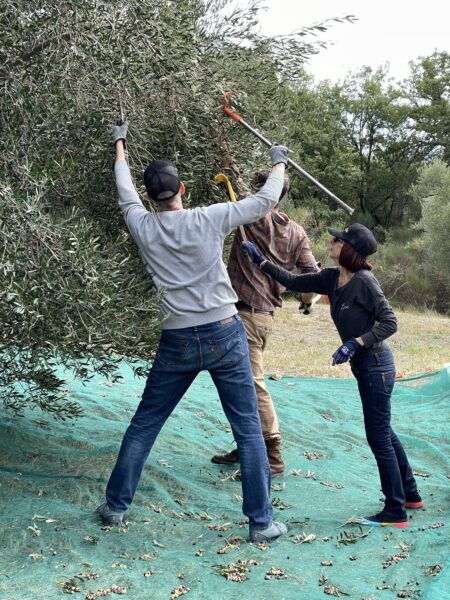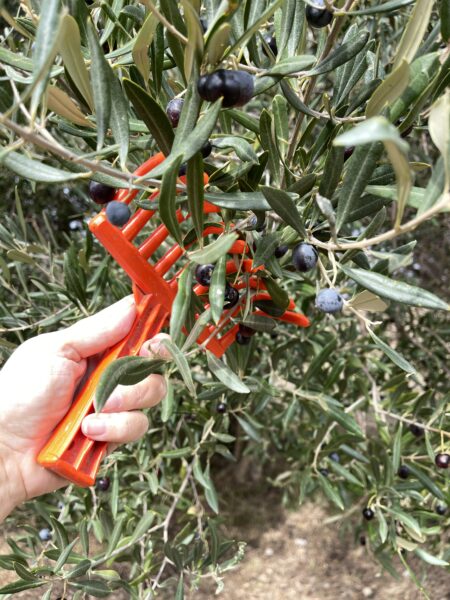It’s hard to imagine a more beautiful vision of paradise than relaxing at a Tuscan farm under an olive tree, watching the breeze blow by and enjoying the delicious fruits of your labors. That’s the little slice of heaven that we had a chance to experience while joining Olio Piro olive oil for their olive harvest.

Olio Piro is the award-winning olive oil company run by brother and sister Romain and Marie-Charlotte Piro with master miller Daniele Lepori. Olio Piro makes its extra-virgin olive oil in limited batches with supreme attention to detail every step along the way. Since 2018, when the Piros established Olio Piro, the olive oil has won numerous accolades. That includes winning the New York International Olive Oil Competition Gold award every year since 2019. Considering the attention to detail, the care for each bottle, and the amazing taste, you can see why we chose Olio Piro as the perfect place to join in the harvest.
(Disclosure: This blog post has affiliate links to Olio Piro. If you click on a link and make a purchase, a portion of the proceeds will go to JollyTomato at no cost to you. Thank you for supporting JollyTomato.)
Olive Trees in Tuscany
The Olio Piro harvest takes place in the Maremma region of Tuscany, where there are olive trees just about everywhere you look. During October and November, you will see farmers stretching nets under their trees and raking out the olives. And all along farm roads, you can see workers driving their crates of olives over to the nearest frantoio, or olive mill.
Why are the olives from this region so special? Enriched by the volcanic soil on the slopes of Mount Amiata, the trees enjoy the perfect balance of sunshine, wind, hot summers, mild winters, and well-drained soil. In fact, some of the olive trees are 300 years old – or more.

On Romain Piro’s farm, the trees grow on a windy hillside with a spectacular view, yielding beautiful olive specimens. (If you were an olive tree on that farm, you would be happy too.) The olives are of the Leccino, Moraiolo, Frantoio, and the rare Olivastra Seggianese variety. The resulting olive oil is a rich blend with a uniquely full-bodied taste.
Harvesting Olives for Olive Oil
For olive oil – unlike wine – freshness is the key. Ideally, you harvest your olives and mill your oil on the same day. That quick turnaround is what allowed us to see the process from start to finish – and taste the fruitful results.

The olive harvesting process is a centuries-old ritual that is both simple and precise. (The workers harvest all of Olio Piro’s olives by hand rather than by machine.) When it’s time to harvest the olives, the farmers lay down large nets that they spread all around the base of the tree. Then they put down something heavy to hold down the nets on all four sides. (In some cases that might be a cat.)

Then they take a small rake that looks like a comb and rake through the branches. They use the rake to vigorously loosen all of the olives from each branch. (Yes, it’s OK to get the olives that are still green.)


Then they carefully roll up the tarp, collecting the olives in one pile, and sort out as many leaves and sticks as possible. Finally, they pour them into a crate.


From here, many farmers go to the local frantoio to process their olives into olive oil. We had a chance to watch several farmers bring their olives to La Seggianese mill in Seggiano. But Olio Piro harvests their olives with special equipment in the brand new, state-of-the-art mill located in nearby Montalcino.
Creating and Bottling Olive Oil
Once the olives arrive at the mill, the olives go through a pure water bath (“olive spa”) for cleaning. Then the olives are crushed with their pit and sent to the malaxer, which kneads the paste slowly at a controlled low temperature (“cold pressed”) until the oil naturally appears. The Olio Piro team watches each batch carefully to make sure it is kneaded for the just the right amount of time. This takes about 40 to 45 minutes.
Next, a centrifuge spins the paste to separate out the oil. After the oil is extracted and filtered (remember, this is the same day that the farmers picked the olives!), it rests in an oxygen-free stainless steel container for at least six days. Then it goes through another unique filtering process before getting bottled.

Olio Piro has developed a special “extra” filtering process that removes even the smallest impurities. The Olio Piro team developed its proprietary double filtration milling system in cooperation with the Italian Consiglio Nazionale delle Ricerche. The result is an oil with an unusually high level of healthful antioxidants and a shelf life that is longer than most extra virgin olive oils. This is especially appealing to chefs because they want their recipes to taste consistently good throughout the year. With the consistent flavor of Olio Piro, they do not have to worry about variable quality of the olive oil.
Tasting Olio Piro Olive Oil
Once the olive oil is in its bottle, the fun part begins: Time to taste! We had an amazing time trying all sorts of olive oil variations at a series of beautiful dinners in Tuscany with the Olio Piro team and friends.
For our first dinner we enjoyed an incredible feast at the beautiful Tuscan home of Chef Monica Patino. Among the multiple ways she used Piro olive oil, one of our favorites was this roasted pumpkin squash served over hummus with crispy kale and hazelnuts.

Roasted pumpkin squash served by Chef Monica Patino.
Would it ever be able to top that amazing meal? Well, the next night, we enjoyed an equally sumptuous meal and wine pairing with Simone and Stefania of Amiata “Vineyards Under the Volcano” in Montegiovi. When we first walked in, Stefania wowed us with this beautiful charcuterie board (paired with olive oil and bread, of course).

The charcuterie board at Amiata vineyards.
(Note: You can book a tasting or a private event at Amiata – you will be impressed by the wine, the food, and the incredible view.)
Dinner in a 700-Year-Old Tower
Now how could it get even better than that? Well… On the third night we had the pleasure of enjoying a pop-up pizza dinner made by master pizzaiola Sergio Donnarumma. Donnarumma is in the process of opening his new restaurant, “Il Palate Chiedo Il Bis” – “The palate comes back twice.” What’s special about the location? The restaurant is located in a beautiful 700-year-old tower in the little village of Archidosso. Amazing! (If you want to see video of the tower and the dinner, check out the reel we made on the Jolly Tomato Instagram.)

The 700-year-old tower in Archidosso.

Oh, and by the way, while you eat the best pizza you’ve had in your life… you will enjoy it even more with a little olive oil on top.

After all of that tasting, stuffed to the gills, we resolved to spend even more time in the new year telling people about Olio Piro olive oil. Have you tried it yet? Head over to Olio Piro and get your very own taste of real Tuscan olives.

 Hi! I'm Jeanne Fratello - a writer, reporter, and food enthusiast who is on a mission to write great stories about food and where your food comes from.
Hi! I'm Jeanne Fratello - a writer, reporter, and food enthusiast who is on a mission to write great stories about food and where your food comes from.
Amazing!
Thanks! xoxo
Love this, but want to go through it with you when you visit. Love. MOM
Thanks, Mom! Will do! xoxo
Lucky you to take that trip! Sounds marvelous and I enjoyed reading about the process of harvesting and processing olives. The meals look delicious, especially the charcuterie board and th epizza!
Thank you, Ruth! It was an amazing experience and I have a whole new respect for the olive oil process! Thanks for stopping by! Jeanne